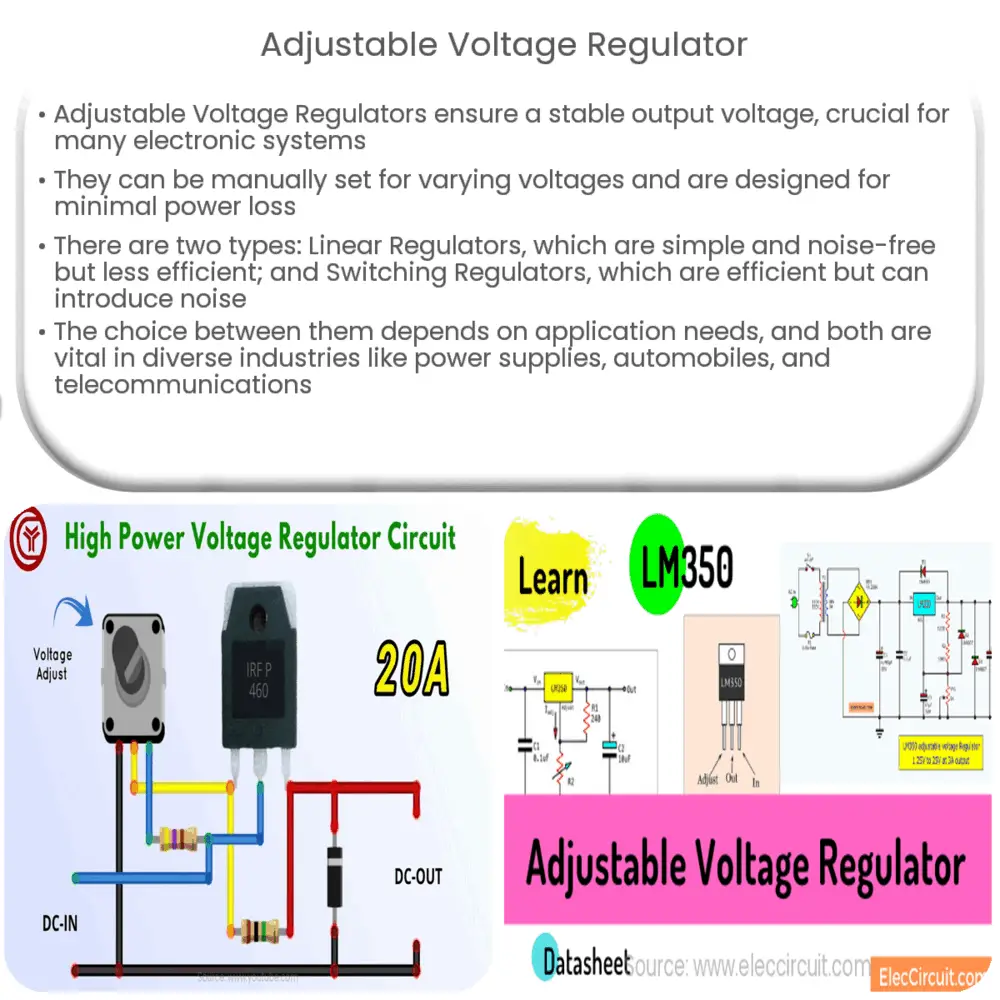Explore the intricacies of Adjustable Voltage Regulators, their characteristics, types, applications, and role in powering electronic devices.

Understanding Adjustable Voltage Regulators
Adjustable Voltage Regulators are integral components in many electrical and electronic devices. They ensure a stable and constant output voltage, despite variations in input voltage or load conditions. This stability is paramount for the proper functioning of many electrical systems.
The operation of an Adjustable Voltage Regulator relies on principles of electromagnetic theory and semiconductors. This article aims to delve into the characteristics, applications, and types of Adjustable Voltage Regulators.
Characteristics of Adjustable Voltage Regulators
- Adjustability: As the name suggests, an Adjustable Voltage Regulator allows for the manual setting of the output voltage. This trait is particularly useful in circumstances where varying voltages are required for different tasks.
- Stability: These regulators provide a constant output voltage. Even in the face of fluctuating input voltages or varying load conditions, the output remains stable. This feature is critical for the consistent performance of electronic devices.
- Efficiency: Adjustable Voltage Regulators are designed to minimize power loss. They convert excess voltage into heat to maintain the desired output voltage.
Types of Adjustable Voltage Regulators
Adjustable Voltage Regulators are broadly classified into two types: Linear and Switching regulators.
- Linear Regulators: These regulators work by using a voltage-controlled current source to force a fixed voltage at the regulator output terminal. They are simple in design and provide clean, noise-free output voltage. However, they are not energy-efficient because the excess power is dissipated as heat.
- Switching Regulators: Switching regulators, on the other hand, are highly efficient. They work by switching a device between saturation (full-on) and cut-off (full-off) states, thus controlling the voltage. These regulators are more complex and can introduce noise into the system.
Each type has its advantages and drawbacks, and the choice depends on the specific requirements of the application. The following section will delve deeper into the applications of these versatile components.
Applications of Adjustable Voltage Regulators
The applications of Adjustable Voltage Regulators span across various industries due to their ability to provide stable and adjustable output voltage. Here are a few notable uses:
- Power Supplies: They are widely used in power supply units of electronic devices such as computers and televisions to stabilize the DC voltages used by the processor and other elements.
- Automobiles: In vehicles, they are used in the alternator to regulate the voltage that charges the car battery.
- Telecommunications: In telecom systems, they are used to maintain stable voltage levels for efficient communication.
Choosing the Right Adjustable Voltage Regulator
Choosing the right Adjustable Voltage Regulator depends on several factors such as the required output voltage, power efficiency, noise tolerance, and cost. Linear regulators are suitable for applications that require low output voltages and minimal noise. However, if efficiency is a priority, switching regulators are the better choice.
Conclusion
In conclusion, Adjustable Voltage Regulators play a crucial role in maintaining the health and performance of electronic devices by providing a stable and adjustable output voltage. Whether it’s linear or switching, the choice of regulator depends heavily on the specific requirements of your application.
As technology continues to evolve and the demand for more efficient and compact devices grows, the development and improvement of Adjustable Voltage Regulators will continue to be a significant area of focus in the field of electronics. In essence, these components, though small, play a huge role in powering our technologically-driven world.

